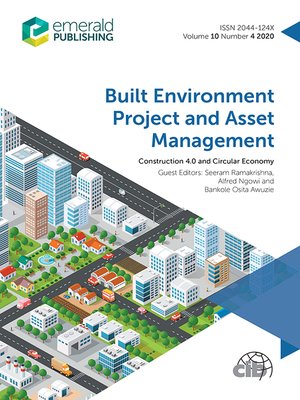Built Environment Project and Asset Management, Volume 10, Number 4
ebook ∣ Construction 4.0 and Circular Economy · Built Environment Project and Asset Management
By Alfred Ngowi

Sign up to save your library
With an OverDrive account, you can save your favorite libraries for at-a-glance information about availability. Find out more about OverDrive accounts.
Find this title in Libby, the library reading app by OverDrive.



Search for a digital library with this title
Title found at these libraries:
| Library Name | Distance |
|---|---|
| Loading... |
The construction industry continues to play a significant role in providing platforms for societal development and sustenance through the development of social and economic infrastructure. The global population is currently growing at an annual rate of 1% and this poses a source of concern for the construction industry given its reliance on the earth's renewable and non-renewable resources. The unsustainable production patterns associated with the construction industry's bid to provide adequate infrastructure stock for society has earned the industry a reputation of undermining society's sustainability goals. These unsustainable production and consumption patterns have been traced to the linear nature of the infrastructure and construction project delivery business models replete in the industry. To change this reputation, scholars have advocated for the holistic adoption and implementation of green and/or sustainable business models and construction practices at the firm and project levels of the industry. The adoption and implementation of circular Economy (CE) in the construction industry has been identified as a means of promoting a veritable transition towards ameliorating the incidence of anthropogenic activities replete within the industry thereby giving rise to entrenchment of sustainable construction practice.
The adoption of the fourth Industrial Revolution (4IR) technologies in economic sectors such as apparel and footwear, retail and resale, transportation, finance, etc. have contributed to successful CE performance. This is particularly the case for example, with the operationalization of the 4R and 9R frameworks. The efficiency of 4IR technologies in driving this transition has been acknowledged in relevant literature especially as it pertains to the operationalisation of the 4R and 9R frameworks.
Furthermore, the COVID-19 pandemic along with its impacts on construction industry resilience has led to the resurgence of the clamour for improved adoption of these innovative and disruptive technologies in supporting improved productivity and sustainability performance within the industry in the unfolding environment, often described as the new normal. Scholars have advocated for players in various economic sectors to leverage on the opportunities availed by the resetting of the global economy because of the COVID-19 shock to drive the incorporation of the CE concept along inherent value chains in these sectors. In the construction industry, similar contributions have been made. For instance, the recently published white paper by the Institution of Civil Engineers (ICE) entitled: 'COVID-19 and the new normal for infrastructure systems -next steps', advocates among other things, significant investment in digitalization towards achieving about 72% of the sustainable development goals indicators which are connected with infrastructure delivery.
Although the construction industry is witnessing the gradual adoption of these technologies, not a lot of attention has been paid to proactively applying these technologies to boost CE performance of industry processes and its products i.e. built assets including buildings and highways, hence ultimately the collective built environment. This is the gap which contributions to this eBook have sought to bridge.
The papers in this eBook focused on the operationalization of the CE concept in the construction industry and the role of 4IR technologies in facilitating this endeavour. Although the utility of 4IR technologies in promoting product and process circularity has been explored, their deployment towards enabling circularity of product and process in the construction industry remains underreported. As such, this eBook...







